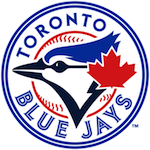Francisco Rosario pitched against Buffalo on Thursday and did not pitch well. I asked Langford what he thought of Rosario?
He wasn't sharp today. He came out of spring training pitching well and his first three starts have been very good and I was pleased. But today his velocity was down and he wasn't as sharp as he has been. But I like him, he has a nice power arm, he is a quiet competitive guy, he is a very good athlete, so we are happy he is in the rotation and I think he will improve as we go and he has a nice major league package, but not today.
I wondered if Rosario's future was in the bullpen?
He throws three pitches, fastball, slider, we worked on a split finger fastball in the spring. His last two starts his split has been up to 90 mph with late hard sink, but not today. I like him in the starting rotation but he has to learn to put guys away earlier, these are the reasons these guys are here. He has things to work on but I like his arm.
David Purcey might be Langford's biggest challenge on the roster, a very good pitcher with control issues.
He is a big strong left handed pitcher, fastball, developing a cutter, good change-up, nice curveball. He is working on his command, we are not teaching any new pitches, he has the kind of stuff that just beats people when he is in the strike zone with it. He has a lot of late life on his pitches so as he becomes more comfortable and confident, he will do well. I saw signs of that in his last start (April 25), the first inning was 28 pitches but we spoke with him and told him to relax, don't worry about results, go at 90% or 95%, don't max out. Suddenly the ball got in there and his confidence started to grow. We had a nice conversation about that and I am hoping he is one of those guys where things happen for him quickly.
What about the command issues?
We are just trying to get him to be smoother, relax, not so jerky. But he is a real hard worker, asks good questions, wants to learn, he is going to be fine.
Ty Taubenheim is new to the organization, what are Langford's impressions?
He throws a fastball, sinker, slider, change, he is a command guy. He is a big intimidating character on the mound, not afraid to pitch inside. I saw him pitch against us last year in the FSL. He is pretty polished, knows his game, just needs command, and pitching to situations and being consistent.
Josh Banks is similar to Taubenheim, a control pitcher.
Josh is another command guy, we are working on a harder slider, a put-away breaking ball. When he elevates the fastball it is hittable and straight, we are trying to create a little bit of tail by finishing better. What I like about him is that he is a real good competitor, he figures out a way and stays to battle.
Dustin McGowan pitched Thursday before being called up to Toronto and he gave up a run on three hits.
Dustin was opening up and everything (all his pitches) was up. He is coming off three good outings and his stuff is great. He just needs innings and to get consistent.
What does he think of Brandon League?
He needs that higher arm slot so the ball sinks for him, it has been sinking good for him this year. He has a power arm with a power sinker. He just needs confidence and it needs to be down and consistent with it. We are not working on any new pitches, he just needs to be consistent with his command.
Ryan Houston has pitched well in his brief time in AAA. Houston is a hard thrower.
We are working on getting him over the top to get a good tilt on his fastball, more of a downward plane. He needs a more consistent breaking ball, sometimes it stays up, again it's just a matter of consistency.
Last year Langford coached Davis Romero in Dunedin.
At the start of last year he was an over the top lefty who threw 90-92 but it was very straight, and the command wasn't good enough and the hitters saw it too good. So we dropped his arm to a three quarter slot, and we have backed him off (dropped his speed). Now we want him to sink the ball, and he has an excellent change-up that he can throw back to back and we taught him the soft breaking ball, but he can now add on to his fastball (add back the speed). So he can throw 86-87 with sink, then dial it up to 92 when he wants. Now he understands himself and is getting the experience to trust that. I like him.
Kyle Yates has the reputation of having a great curveball.
He has a very nice curveball, tight rotation, looks like a fastball coming out of his hand. He throws the curve, a fastball, and a change-up. He did a nice job for us in the FSL last year. I haven't kept track of him this year.
Kurt Isenberg
Kurt is a converter outfielder. He has late life on his fastball and a good change-up, he is working on a better breaking ball, a hard one and a soft one.
Danny Hill
Sinker, slider, split. It's a command issue with him, he needs to understand that a ground ball on the first two pitches is better than a strikeout. These are the things a young pitcher has to go through.
Batters Box would like to thank Rick Langford for taking the time to answer our questions.




